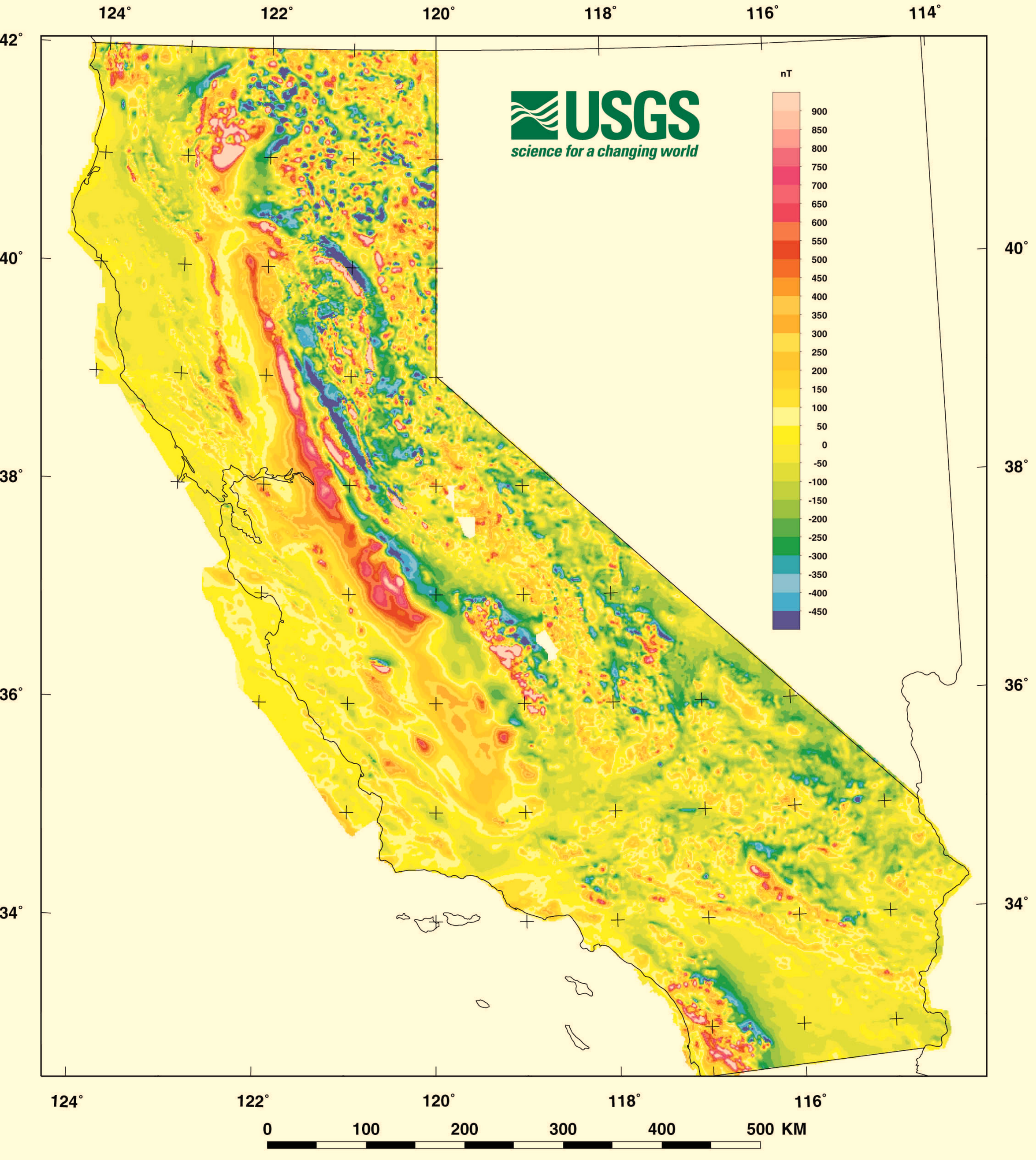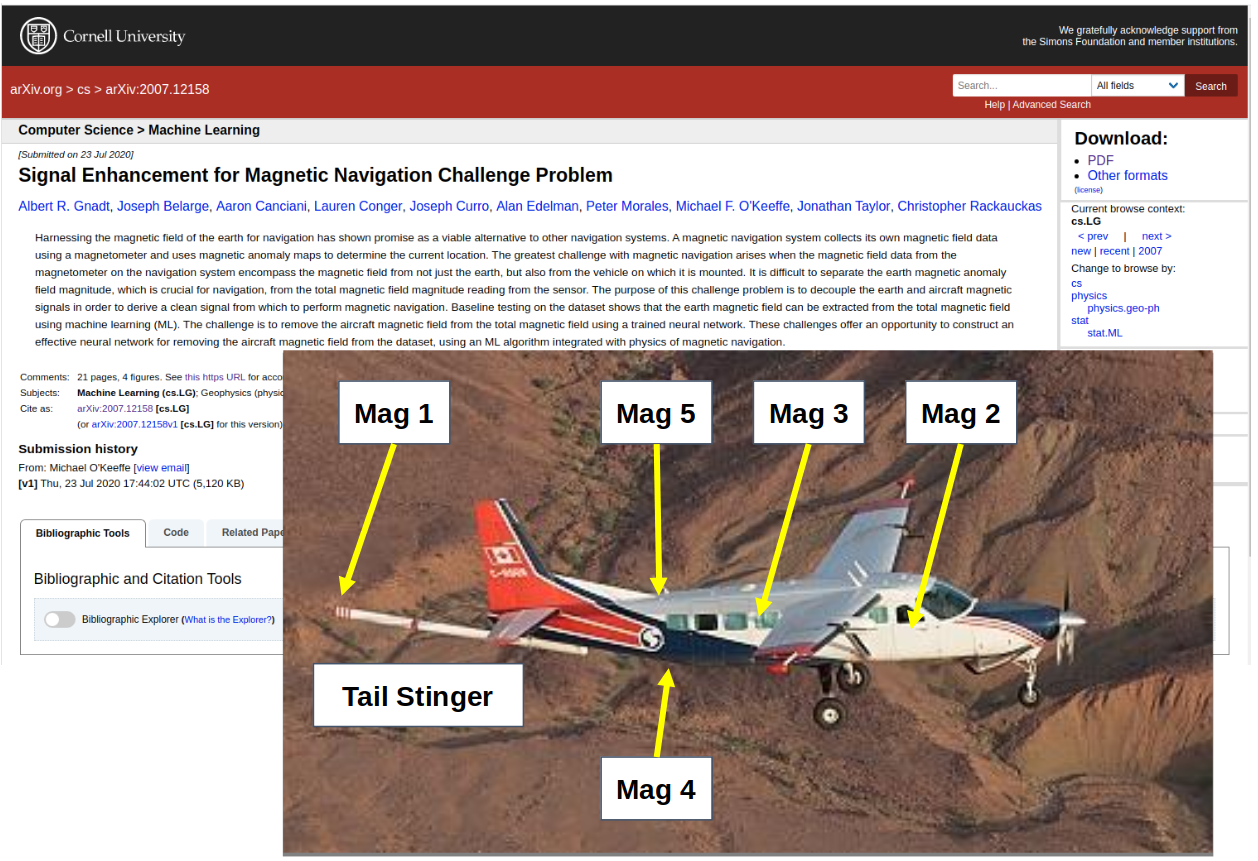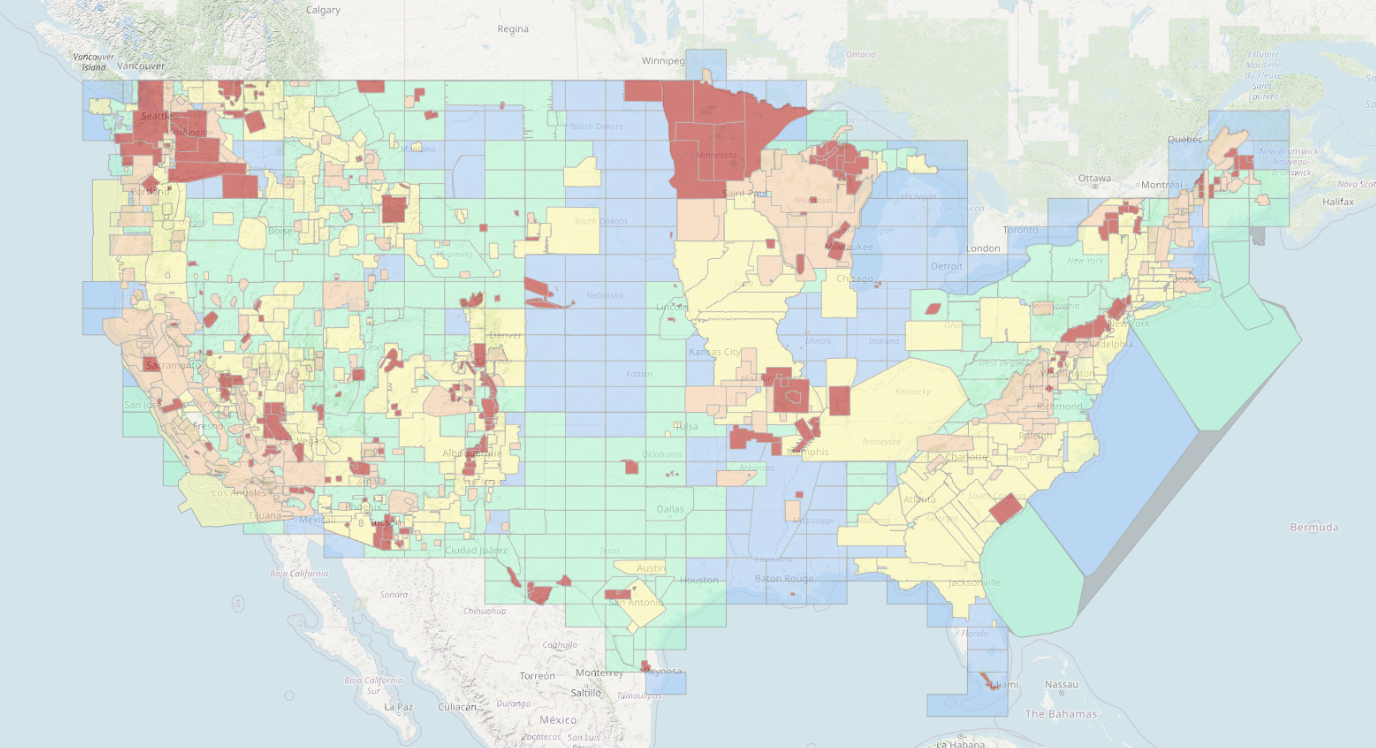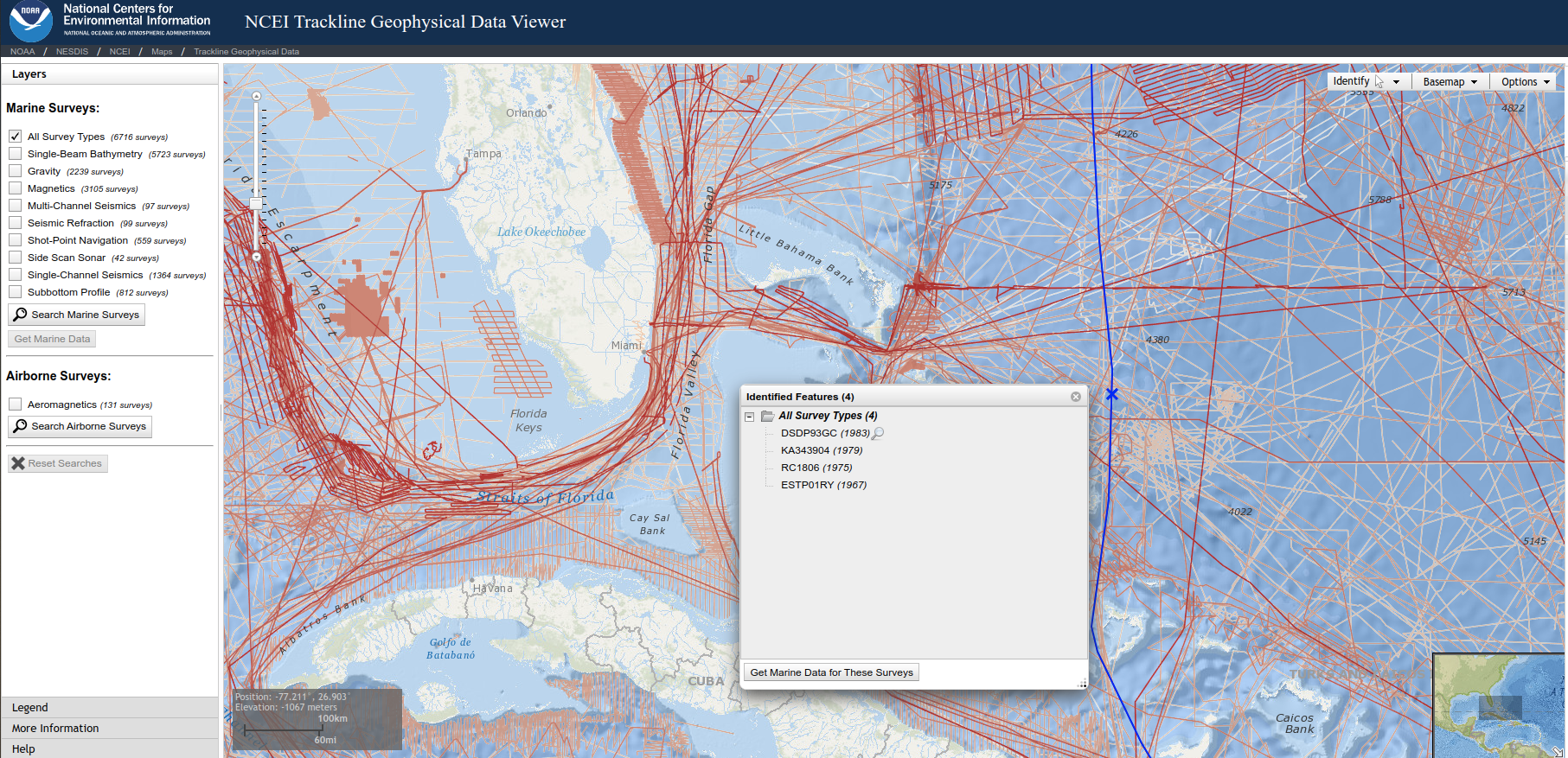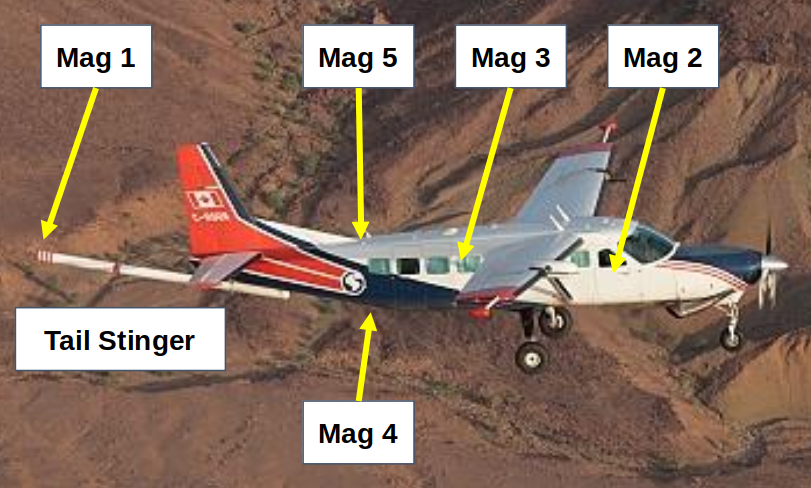drms (generic function with 1 method)Magnetic Anomaly Navigation Tutorial
IEEE/ION PLANS 2023, Monterey, CA
The views expressed in this article are those of the author and do not necessarily reflect the official policy or position of the United States Government, Department of Defense, United States Air Force or Air University.
Distribution A: Authorized for public release. Distribution is unlimited. Case No. 2023-0277.
Magnetic Anomaly Navigation Tutorial
https://rpubs.com/friendly/test-newcommands https://quarto.org/docs/authoring/markdown-basics.html#equations
https://stackoverflow.com/questions/41362012/how-to-insert-font-awesome-icons-in-mathjax
Font-Awesome will only work for html type output
\[ \newcommand{\dvec}[1]{\dot{\vec{#1}}} \newcommand{\ddvec}[1]{\ddot{\vec{#1}}} \newcommand{\mat}[1]{\mathbf{#1}} \newcommand{\earth}{{\oplus}} \newcommand{\ext}{\text{ext}} \newcommand{\faPlane}{\class{fa fa-plane}{}} \newcommand{\plane}{\class{fa fa-plane}{}} \newcommand{\sensor}{\text{Sensor}} \]
Loads julia configurations and sources needed code.
- Overview of Magnetic Anomaly Navigation
- Tutorial goals:
- Calibrate and Navigate an aircraft
Outline
Schedule
Tutorial is 90 minutes total:
- 40 minutes
- 10 minutes break
- 40 minutes
Outline
Magnetic Anomaly Navigation Overview
Requirements for MagNav
Discuss publicly available MagNav software and dataset
Learn and perform traditional aircraft calibration
- Tolles-Lawson
Evaluate navigation performance
Calibration/noise removal
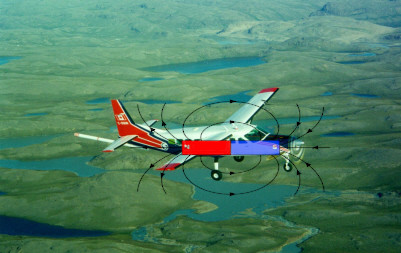
Navigation performance improvement
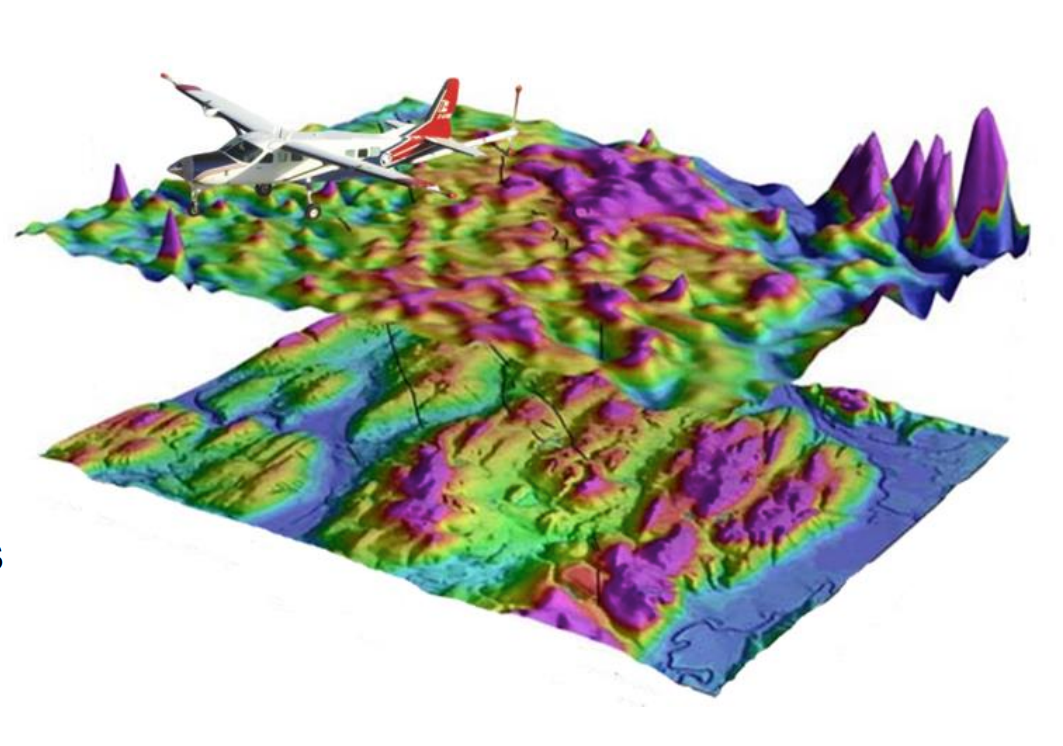
MagNav Overview
Magnetic Anomaly Navigation Overview
Refrigerator magnet 
Earth’s core field (compass) 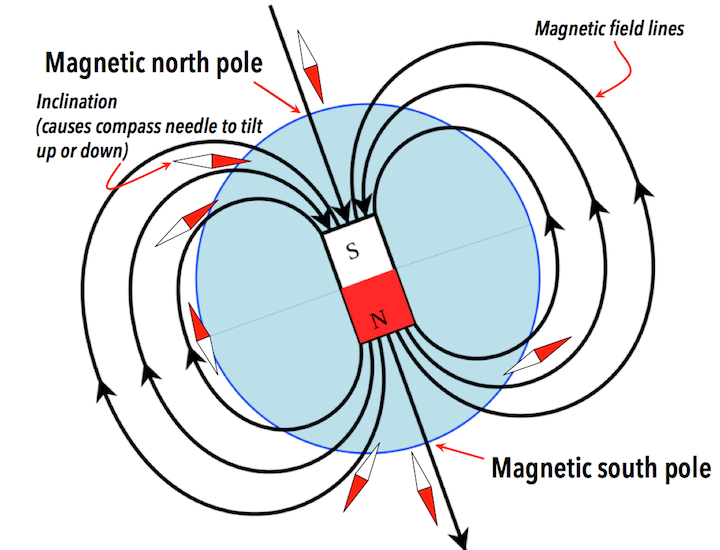
Crustal magnetic anomaly 
1 000 000 nT
Range \(\pm\) 500 nT
Resolution \(\sim\) 1 nT https://mrdata.usgs.gov/magnetic/ (Bankey et al. 2002)
Inertial Navigation
Inertial Measurement Unit (IMU)
- measures accelerations
- measures rotation rates
To get position from accleration, you have to integrate twice
- continuously adds noise to your position estimate
Drifting position estimate needs to be corrected
- Magnetic Anomaly Navigation matches to magnetic anomaly map

Earth Magnetic Anomaly Grid 2-arcsec v3
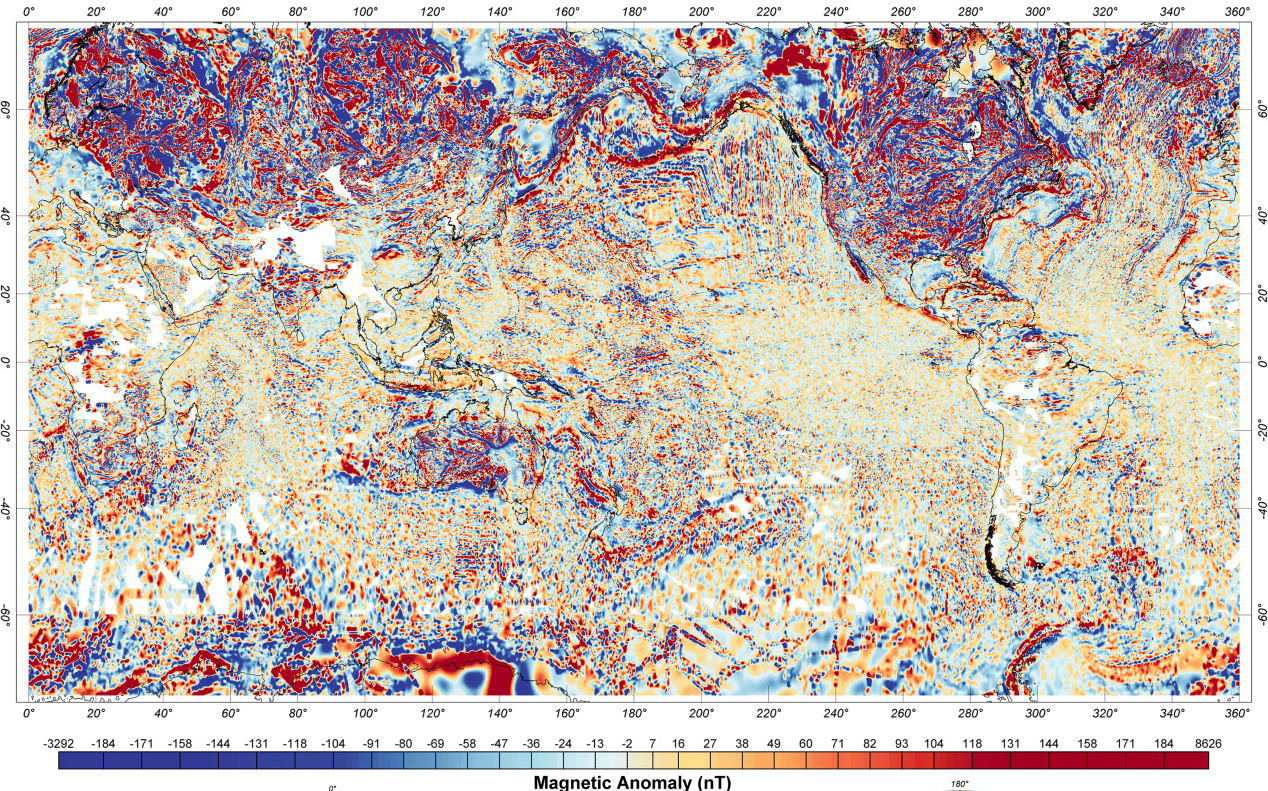
Map-based navigation
Features are required to navigate
Magnetic anomaly closely tied to geology
- less variation in coastal region
- direction variation in Central Valley
- more structure in Sierra Nevada mountains
Area and direction of travel make a difference
Interpretation of magnetic anomaly
-The primary sensor used is a scalar magnetometer which measures: \(|\vec{B}|\)
-The field is a vector \(\vec{B}\)
-Interpretation of \(|\vec{B}|\) relies on understanding
\(|\vec{B}_\sensor| = |\vec{B}_\earth + \vec{B}_\text{anomaly}|\)
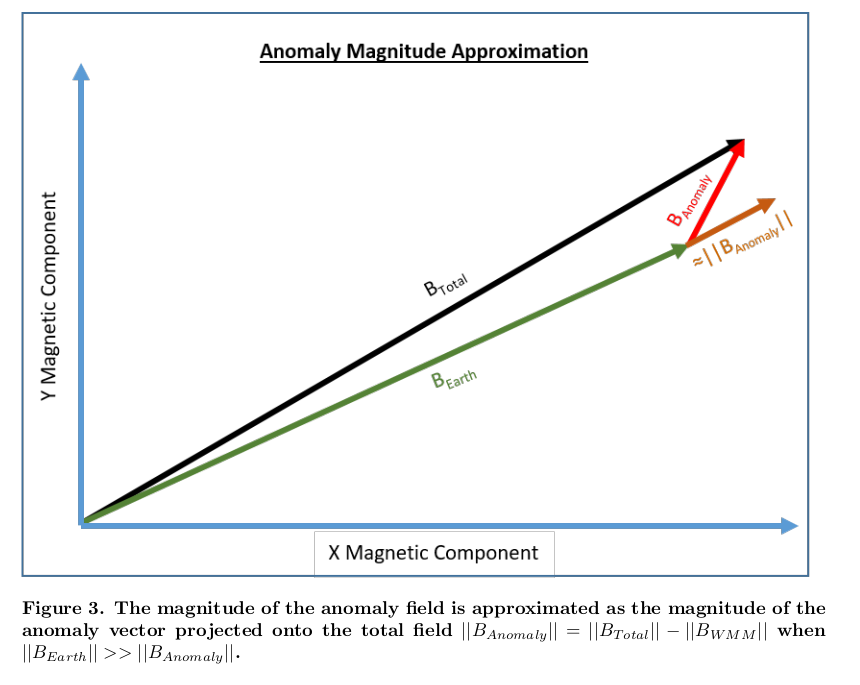
An airplane is a big magnet that flies

\(|\vec{B}| = |\vec{B}_\earth + \vec{B}_\text{anomaly} + \vec{B}_\plane|\)
Aircraft Calibration
Sensor placement and installation
- Engineered location
- Stinger
- Survey for placement
- Non-magnetic fasteners
Degaussing
Algorithms

Software and Data for Tutorial
MIT-AF AI Accelerator MagNav project
Collected data and made publicly available:
Created software suite published on GitHub:
- Written in Julia https://juilalang.org
- https://github.com/MIT-AI-Accelerator/MagNav.jl
- Docker container https://hub.docker.com/r/jtaylormit/magnav
Data run-thru
- Collected data made publicly available:
- https://zenodo.org/record/6327685
- Hold-out data for challenge problem
- Recorded flight data near Ottawa, ON
- Position, velocity, attitude (truth)
- Tail Stinger
- 4 magnetometers in cabin
- Current and voltage sensors
- 10 Hz
- Ground station reference sensor
- 10 Hz
- Magnetic Maps of flight area
- Calibration maneuvers
- Flight crew notes
- Power lines
- Railroad tracks
- On-board activities
- power on/off to systems
- movement of iron bars
- Professional calibration results
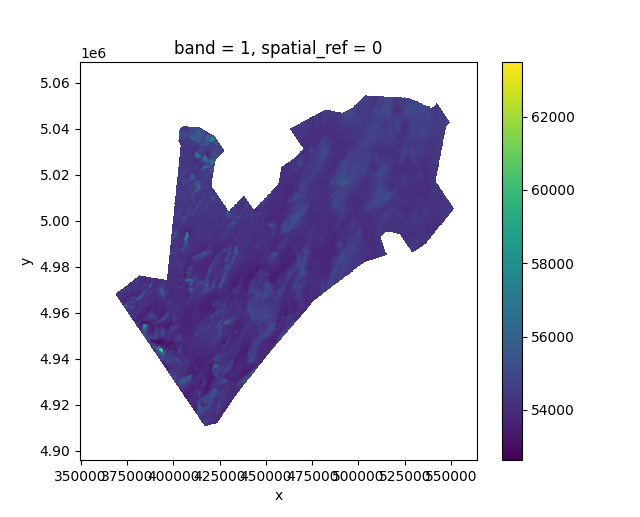
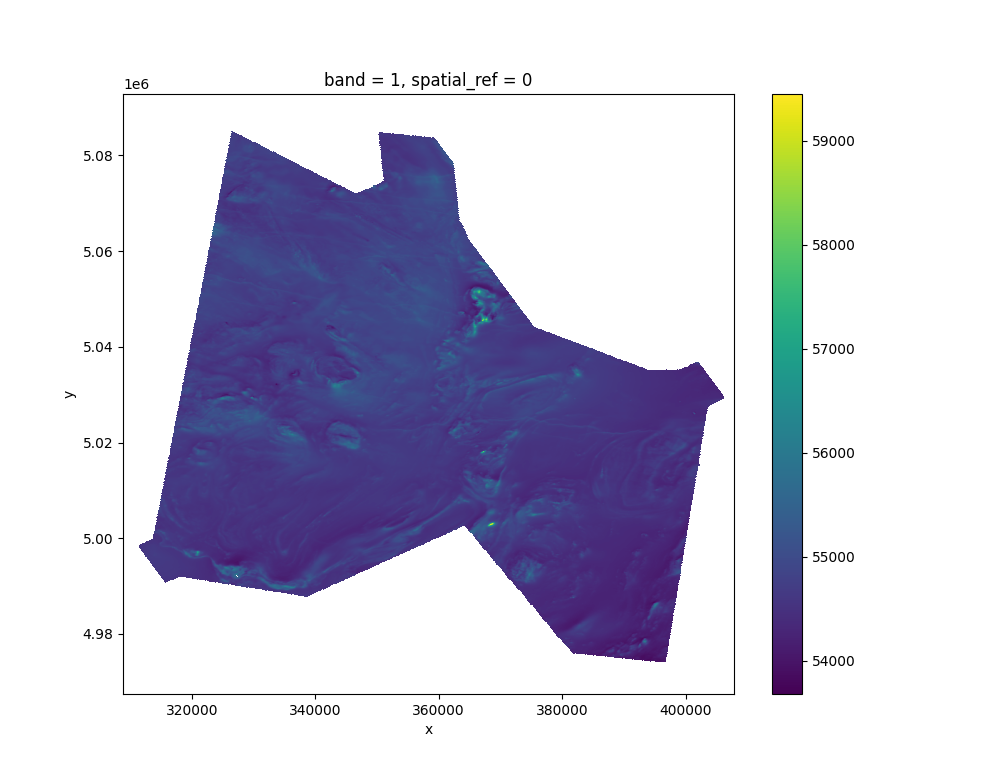
MagNav Software - MagNav.jl
https://github.com/MIT-AI-Accelerator/MagNav.jl
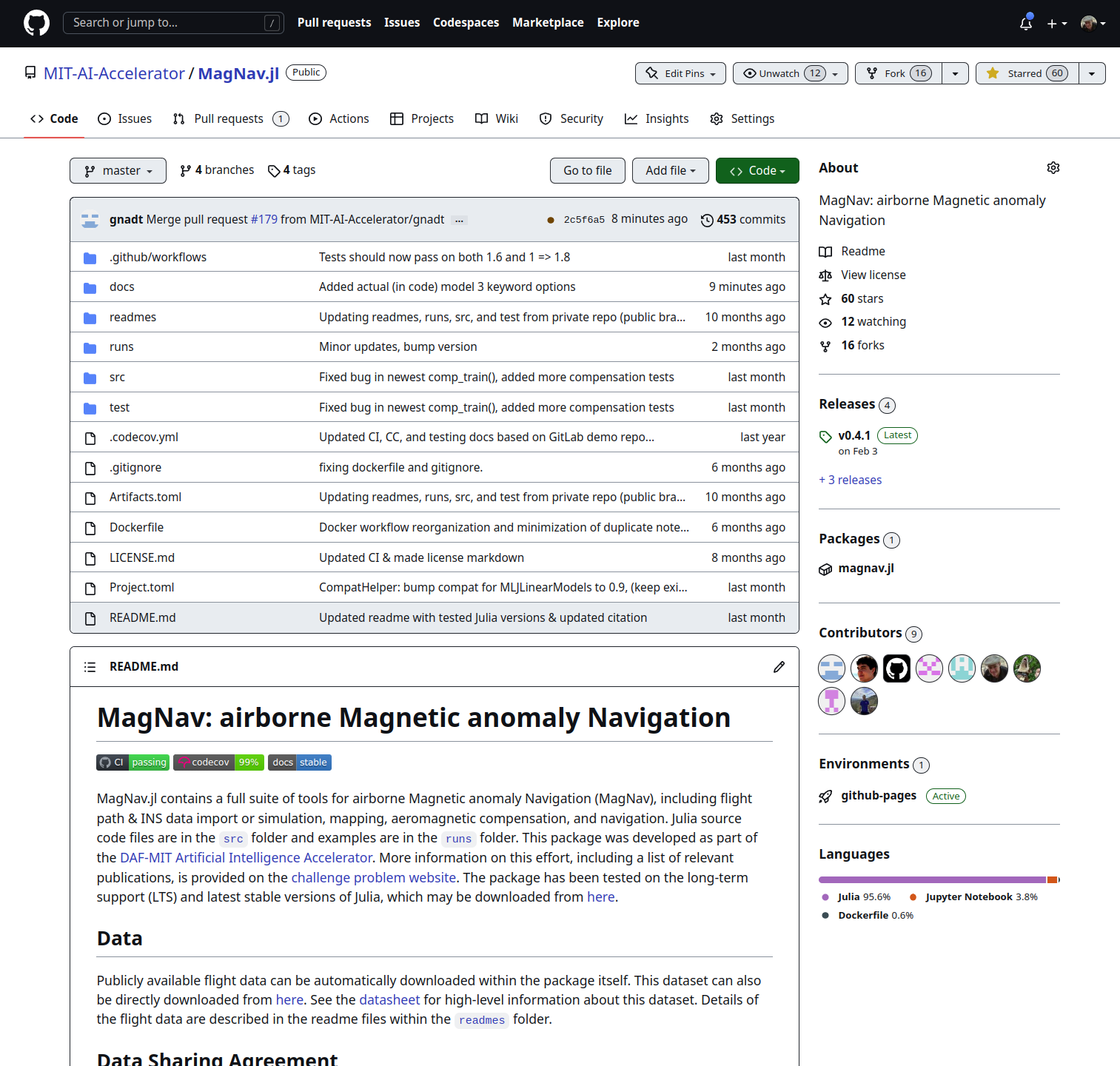
MagNav.jl Documentation
MagNav.jl Docker image
https://hub.docker.com/r/jtaylormit/magnav
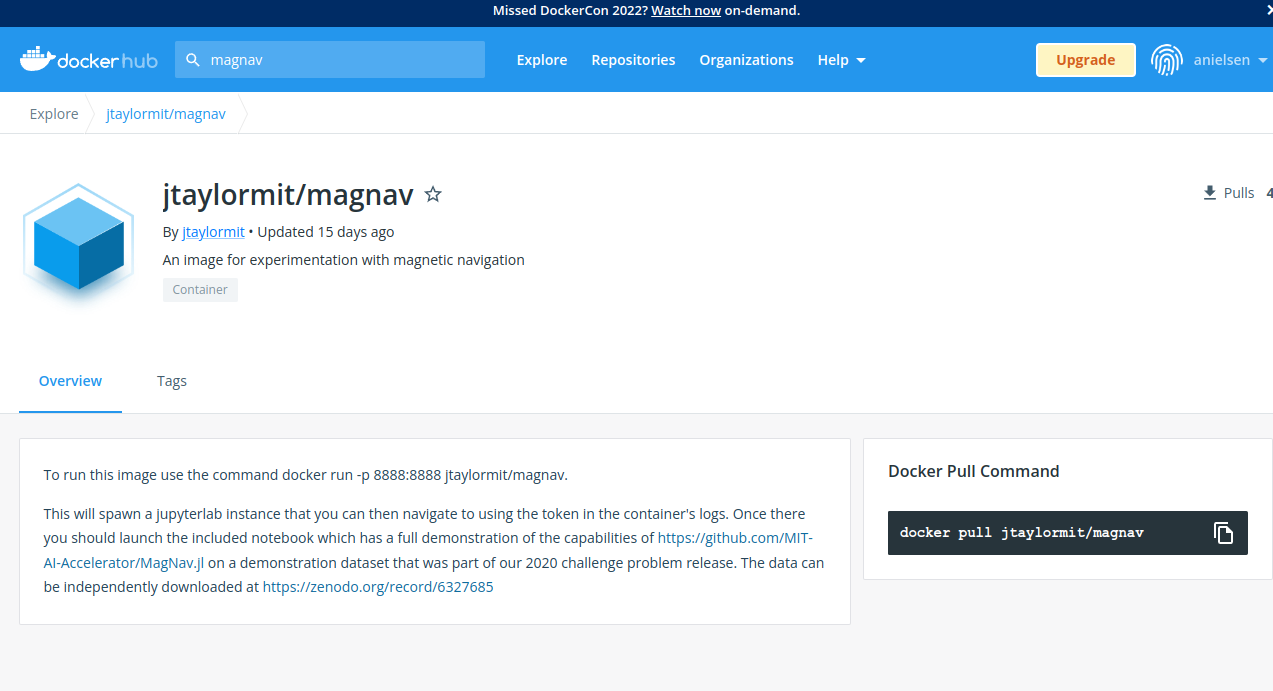
Challenge problem
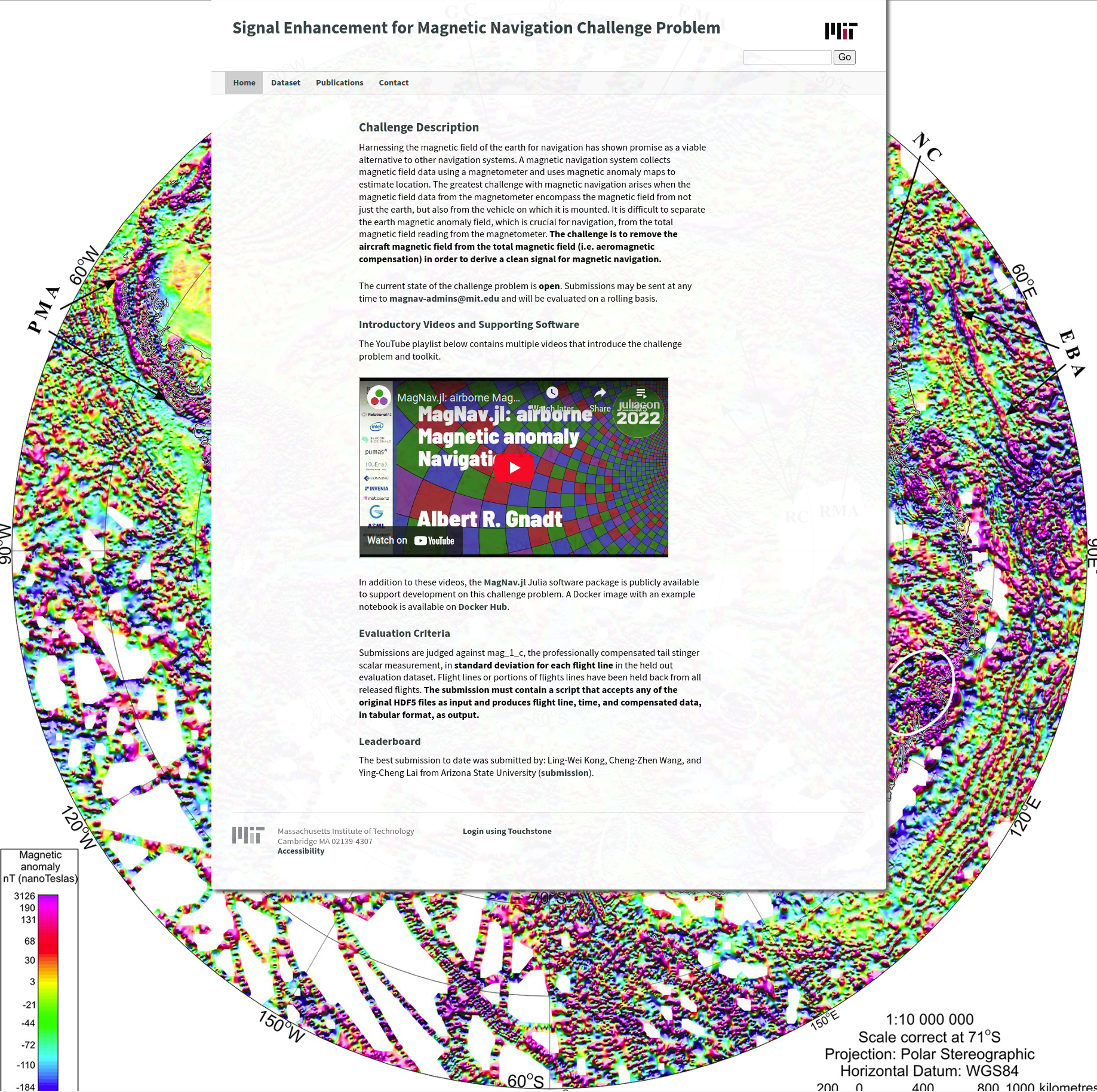
Julia Language
Get MagNav.jl and use it
Maps
Airborne magnetic anomaly surveys
- Usually performed in smaller area for geological interpretation
- Large anomaly maps merged together in mosaic using a leveling process
- Meant to merge long spatial wavelengths
- Many anomaly surveys pre-date GPS
- Geolocated via air-crew observations
- Typically remove space-weather effects with ground-station
Marine track surveys
- Often single long track following ship
- Many pre-date GPS
- Use ship’s positioning
- Typically no space weather correction
Upward continuation
Magnetic anomaly maps are usually made at a single altitude.
The process of taking a magnetic map from one altitude to another.
- \(F(B_\text{up}) = F(B_\text{known}) e^{-\Delta z |k|}\)
- Assumes a flat Earth model with all the sources below
- (Blakely 1995)
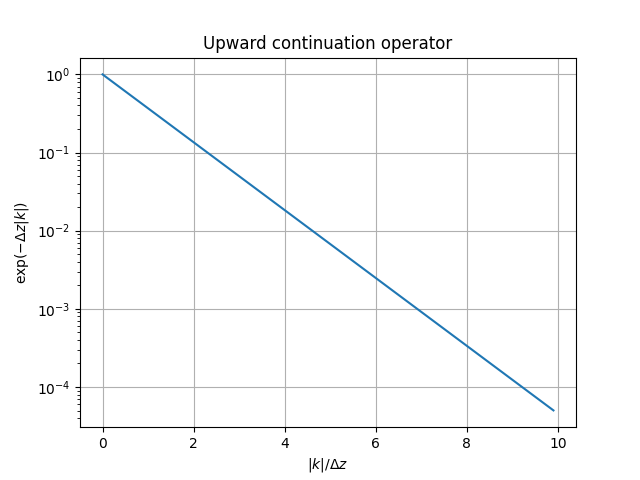
Dangerous downward continuation
The process of taking a magnetic map from one altitude to another.
- \(F(B_\text{down}) = F(B_\text{known}) e^{+\Delta z |k|}\)
- Noise can be amplified
- Techniques to do this exist, and involve some kind of regularization or source estimation
- (Blakely 1995)

Calibration
Tolles-Lawson
- Calibration technique developed in WW2 for submarine hunting
- Declassified in 1950’s and patented
- Standard calibration technique used for aero-magnetic surveys
- Developed by (Leliak 1961)

\[ \begin{align*} |B_\mathrm{Sensor}| &= |\vec{B}_\ext + \vec{B}_\faPlane|\\ &= \sqrt{ |B_\ext|^2 + |B_\faPlane|^2 + 2 |B_\ext||B_\faPlane|\cos\theta}\\ |B_\text{Sensor}| &= |B_\ext| \sqrt{ 1 + \frac{|B_\faPlane|^2}{|B_\ext|^2} + 2\frac{|B_\faPlane|}{|B_\ext|}\cos\theta} \end{align*} \]
Tolles-Lawson Path to Calibration 1/2
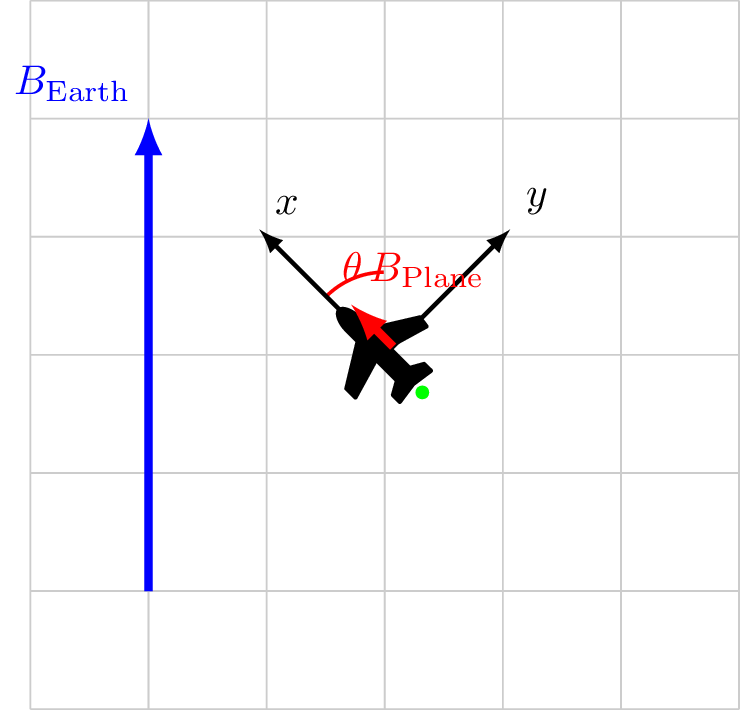
\[
\begin{align*}
|B_\text{Sensor}| &= |\vec{B}_\ext + \vec{B}_\faPlane|\\
&= \sqrt{ |B_\ext|^2 + |B_\faPlane|^2 + 2 |B_\ext||B_\faPlane|\cos\theta}\\
|B_\text{Sensor}| &= |B_\ext| \sqrt{ 1 + 2\frac{|B_\faPlane|}{|B_\ext|}\cos\theta}\\
&\approx |B_\ext| + |B_\faPlane|\cos\theta + \cdots
\end{align*}
\]
Path to Calibration
Measure \(\cos\theta\)
Solve \(|B_\text{sensor}| = |B_\ext| + |B_\plane|\cos\theta\)
Assuming \(|B_\ext|\) is known or constant
Tolles-Lawson Path to Calibration 2/2
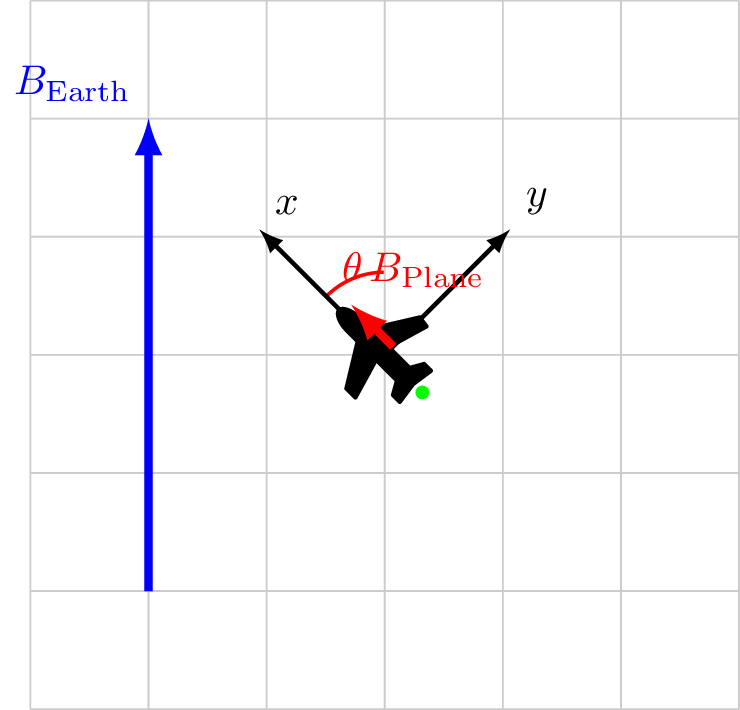
Path to Calibration
Measure \(\cos\theta\)
Solve \(|B_\text{sensor}| = |B_\ext| + |B_\faPlane|\cos\theta\)
Assuming \(|B_\ext|\) is known or constant
How to measure \(\cos\theta\)?
Use a vector magnetometer
Rotate aircraft in \(|B_\ext|\)
Compute direction cosines…
Direction cosines
- The direction cosines are computed in the vector magnetometer reference frame
- The magnetometer is fixed to aircraft body reference frame \[ \begin{aligned} \cos X = & \frac{B_x}{\sqrt{B_x^2 + B_y^2 + B_z^2}}\\ \cos Y = & \frac{B_y}{\sqrt{B_x^2 + B_y^2 + B_z^2}}\\ \cos Z = & \frac{B_z}{\sqrt{B_x^2 + B_y^2 + B_z^2}} \end{aligned} \]
In the 2-D example, \(B_z = 0\)
Calibration 1/4

Coordinate system fixed to aircraft
\[\vec{B}_\mathrm{Sensor} = \vec{B}_\ext + \vec{B}_\faPlane\]
\[
\begin{alignat*}{3}
\vec{B}_\ext &= 4.0 \hat{x} && + 0.0 \hat{y} \\
\vec{B}_\faPlane &= 0.5 \hat{x} && +0.0 \hat{y} \\
\vec{B}_\text{Sensor} &= 4.5 \hat{x} && + 0.0 \hat{y} \\
|B_\text{Sensor}| &= 4.5 && \\
\cos X &= \frac{4.5}{4.5} && = 1\\
\cos Y &= \frac{0.0}{4.5} && = 0\\
\end{alignat*}
\]
Calibration 2/4
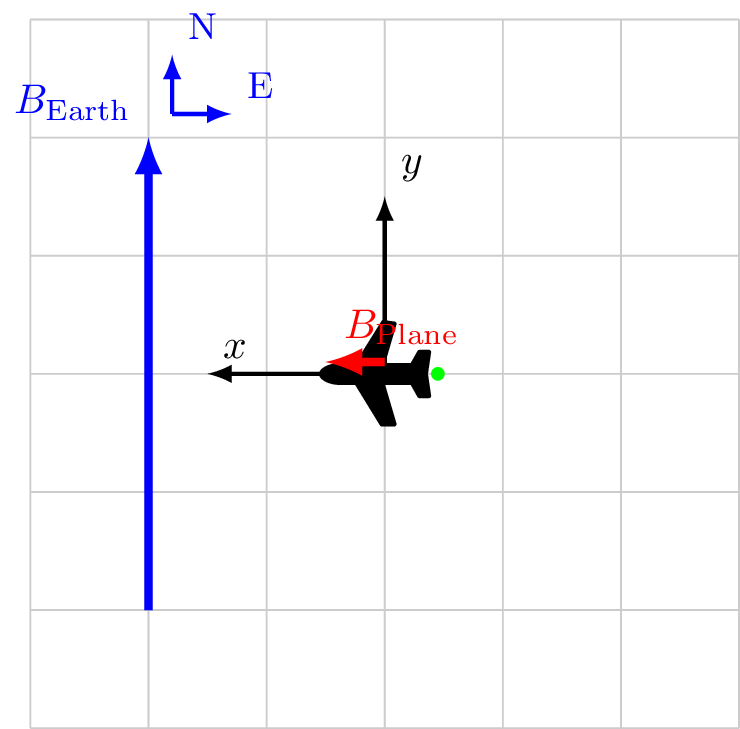
Coordinate system fixed to aircraft
\[\vec{B}_\text{Sensor} = \vec{B}_\ext + \vec{B}_\faPlane\]
\[
\begin{alignat*}{3}
\vec{B}_\ext &= 0.0 \hat{x} && + 4.0 \hat{y} \\
\vec{B}_\faPlane &= 0.5 \hat{x} && + 0.0 \hat{y} \\
\vec{B}_\text{Sensor} &= 0.5 \hat{x} && + 4.0 \hat{y} \\
|B_\text{Sensor}| &= 4.007 && \\
\cos X &= \frac{0.5}{4.007} && \ne 0 \rightarrow 82.8^\circ\\
\cos Y &= \frac{4.0}{4.007} && \approx 1\\
\end{alignat*}
\]
Calibration 3/4
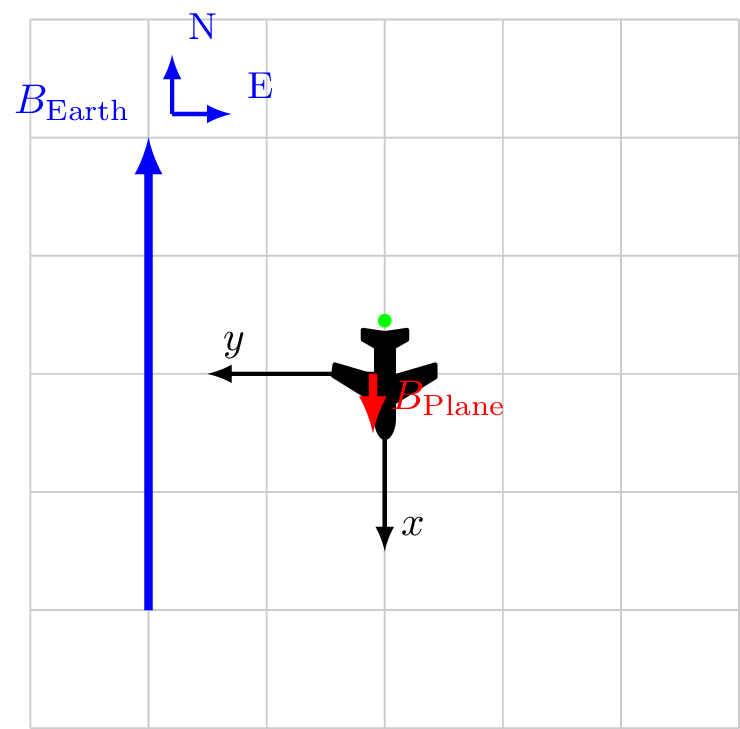
Coordinate system fixed to aircraft
\[\vec{B}_\text{Sensor} = \vec{B}_\ext + \vec{B}_\faPlane\]
\[
\begin{alignat*}{3}
\vec{B}_\ext &= -4.0 \hat{x} && + 0.0 \hat{y} \\
\vec{B}_\faPlane &= 0.5 \hat{x} && + 0.0 \hat{y} \\
\vec{B}_\text{Sensor} &= -3.5 \hat{x} && + 0.0 \hat{y} \\
|B_\text{Sensor}| &= 3.5 && \\
\cos X &= \frac{-3.5}{3.5} && = -1\\
\cos Y &= \frac{0}{3.5} && = 0\\
\end{alignat*}
\]
Calibration 4/4
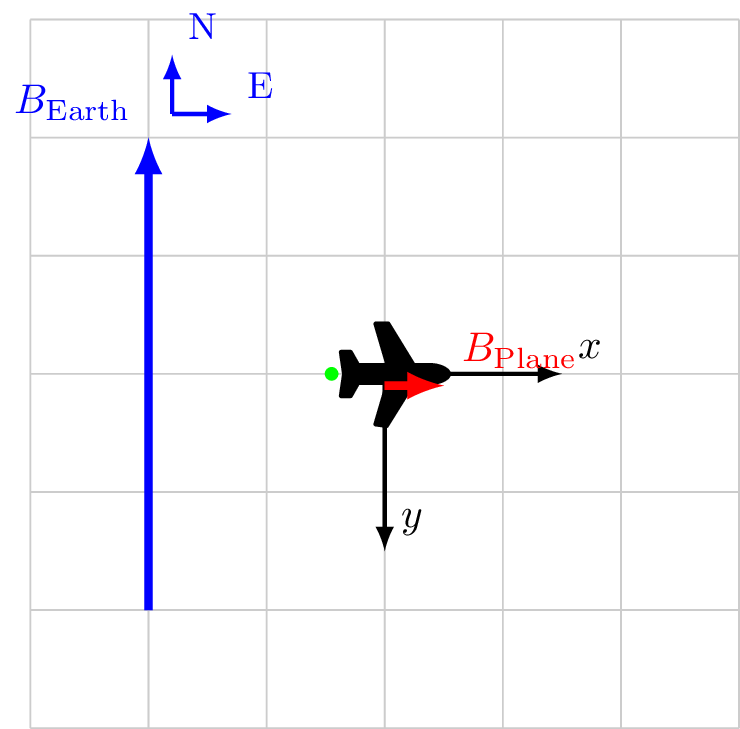
Coordinate system fixed to aircraft
\[\vec{B}_\text{Sensor} = \vec{B}_\ext + \vec{B}_\faPlane\]
\[
\begin{alignat*}{3}
\vec{B}_\ext &= 0.0 \hat{x} && + -4.0 \hat{y} \\
\vec{B}_\faPlane &= 0.5 \hat{x} && + 0.0 \hat{y} \\
\vec{B}_\text{Sensor} &= 0.5 \hat{x} && + -4.0 \hat{y} \\
|B_\text{Sensor}| &= 4.007 &&\\
\cos X &= \frac{0.5}{4.007} && \ne 0\\
\cos Y &= \frac{-4.0}{4.007} && \approx -1\\
\end{alignat*}
\]
Standard calibration model
\[|\vec{B}| = |\vec{B}_\ext + \vec{B}_\faPlane|\]
\[ \begin{array}{ l B c B c B c } \vec{B}_\faPlane & = & \vec{B}_\text{Permanent} & + & \vec{B}_\text{Induced} & + & \vec{B}_\text{Eddy}\\ & = & \vec{P}_\text{constant} {} & + &{} M_{3\times3} \vec{B }_\ext {} & + & {} S_{3\times3} \frac{\partial}{\partial t} \vec{B}_\ext \end{array} \]
\(M_{3\times3}\) is symmetric \(\rightarrow\) 6 independent elements
Total of 18 elements


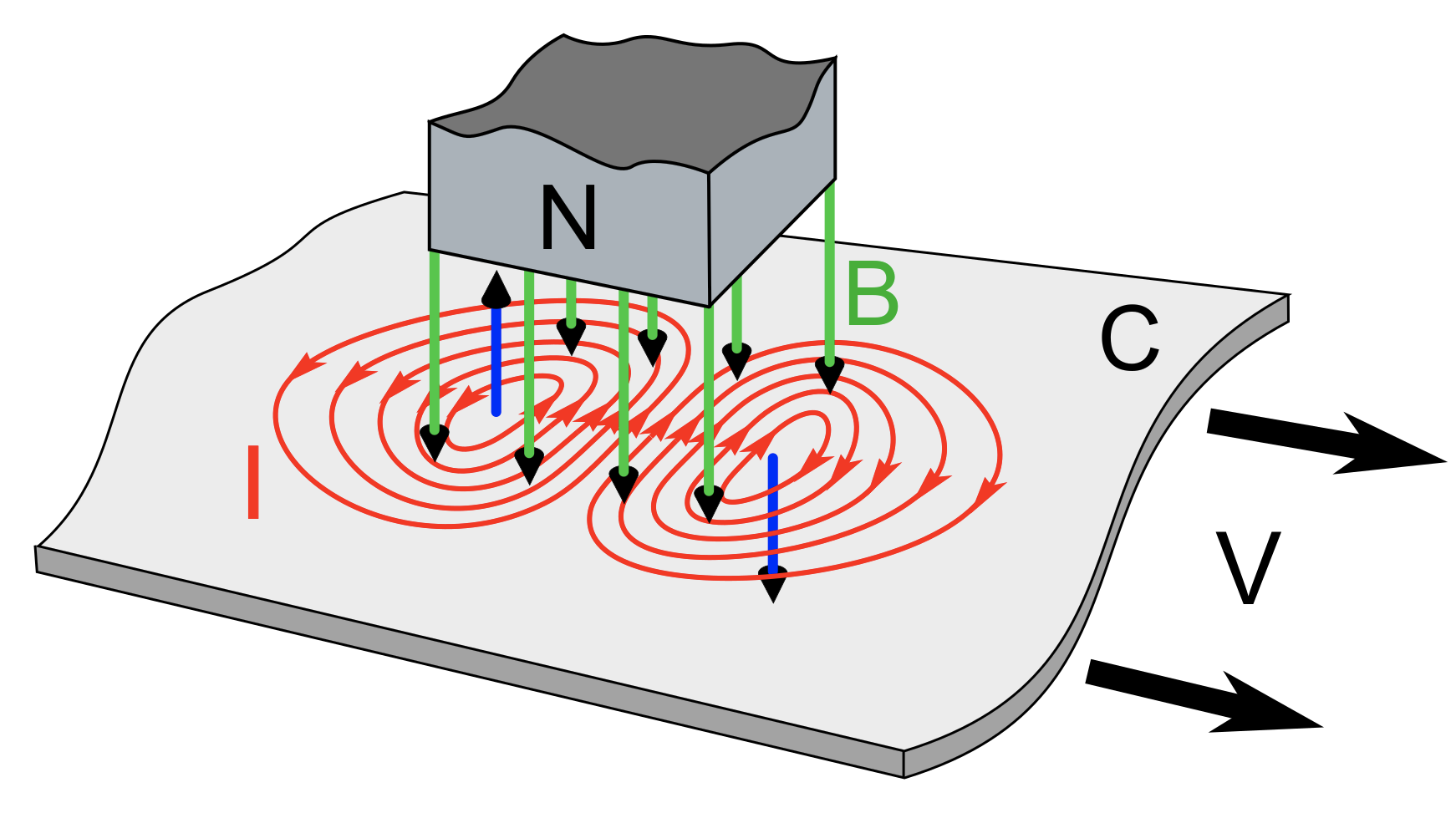
Use the same direction cosines, now with \(B_z\)
The direction cosines are computed from the vector magnetometer
\[ \begin{aligned} \cos X = & \frac{B_x}{\sqrt{B_x^2 + B_y^2 + B_z^2}}\\ \cos Y = & \frac{B_y}{\sqrt{B_x^2 + B_y^2 + B_z^2}}\\ \cos Z = & \frac{B_z}{\sqrt{B_x^2 + B_y^2 + B_z^2}} \end{aligned} \]
Tolles-Lawson full implementation
\[
\begin{aligned}
B_\plane & = & & { c_1 \cos X + c_2 \cos Y + c_3 \cos Z }+ \\
& & B_\ext & {[ c_4 \cos^2 X + c_5 \cos X \cos Y + c_6 \cos X \cos Z +} \\
& & & { c_7 \cos^2 Y + c_8 \cos Y \cos Z + c_9 \cos^2 Z ] + } \\
& & B_\ext & { [ c_{10} \cos X \cos' X + c_{11} \cos X \cos' Y + c_{12} \cos X \cos' Z }+ \\
& & & { c_{13} \cos Y \cos' X + c_{14} \cos Y \cos' Y + c_{15} \cos Y \cos' Z +} \\
& & & { c_{16} \cos Z \cos' X + c_{17} \cos Z \cos' Y + c_{18} \cos Z \cos' Z ] }
\end{aligned}
\]
We need a method to solve for \(c_1 \ldots c_{18}\)
How to sample the range of possible angles?
Calibration manuevers - Tolles-Lawson
Fly the aircraft in a series of Roll, Pitch, Yaw maneuvers
High-altitude
Altitude of a known map
Maneuver angle should depend upon the expected aircraft dynamics
- Barrel Rolls?
Typically at each cardinal heading
- 3 rolls \(\pm 10^\circ\) at 1 Hz
- 3 pitches \(\pm 10^\circ\) at 1 Hz
- 3 yaws \(\pm 10^\circ\) at 1 Hz
Pack your air-sickness bag
(W. E. Tolles and Lawson 1950), (W. E. Tolles 1954), (W. E. Tolles 1955), (Gnadt, Wollaber, and Nielsen 2022)
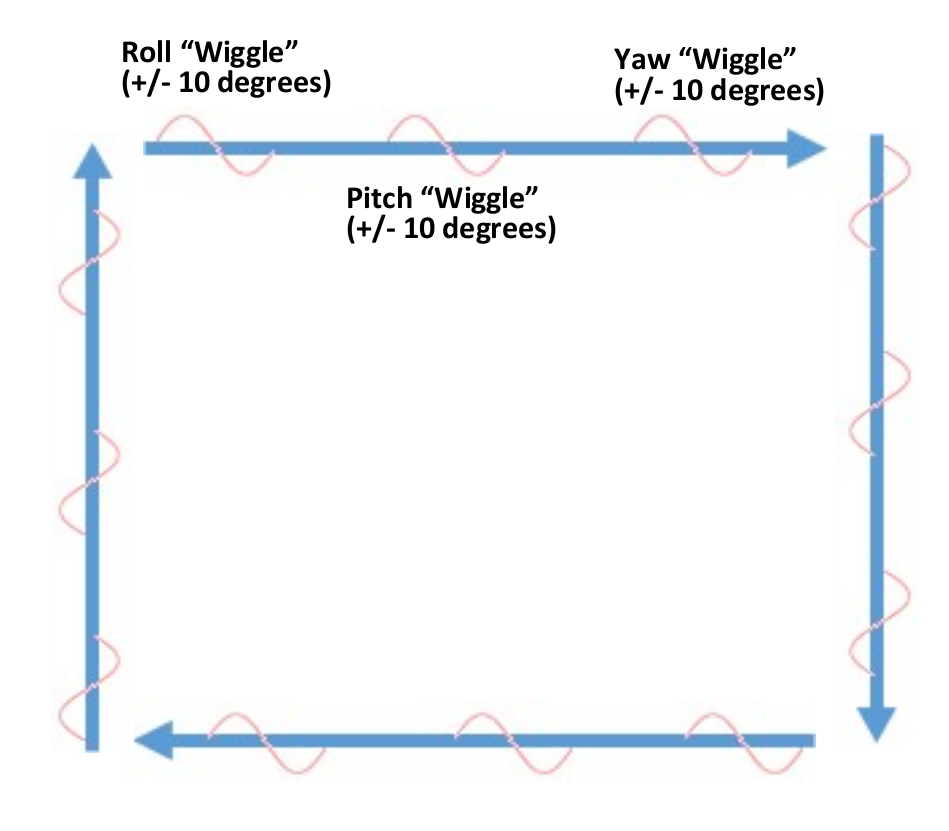
Construct Tolles-Lawson \(A\) matrix
\[ A = \begin{bmatrix} \cos X_1 & \cdots & \cos X_N\\ \cos Y_1 & \cdots & \cos Y_N \\ \cos Z_1 & \cdots & \cos Z_N\\ B_\ext \cos^2 X_1 & \cdots & B_\ext \cos^2 X_N\\ B_\ext \cos X_1 \cos Y_1 & \cdots & B_\ext \cos X_N \cos Y_N\\ B_\ext \cos X_1 \cos Z_1 & \cdots & B_\ext \cos X_N \cos Z_N \\ B_\ext \cos^2 Y_1 & \cdots & B_\ext \cos^2 Y_N \\ B_\ext \cos Y_1 \cos Z_1 & \cdots & B_\ext \cos Y_N \cos Z_N\\ B_\ext \cos^2 Z_1 & \cdots & B_\ext \cos^2 Z_N\\ B_\ext \cos X_1 \cos' X_1 & \cdots & B_\ext \cos X_N \cos' X_N \\ B_\ext \cos X_1 \cos' Y_1 & \cdots & B_\ext \cos X_N \cos' Y_N\\ B_\ext \cos X_1 \cos' Z_1 & \cdots & B_\ext \cos X_N \cos' Z_N\\ B_\ext \cos Y_1 \cos' X_1 & \cdots & B_\ext \cos Y_N \cos' X_N\\ \vdots & & \vdots \\ B_\ext \cos Z_1 \cos' Z_1 & \cdots & B_\ext \cos Z_N \cos' Z_N \\ \end{bmatrix} \]
\(B_\ext\) is the magnitude of the external field. We assume that \[
B_\ext = \sqrt{B_x^2 + B_y^2 + B_z^2}
\]
Equivalently that the vector mags only see external field. The anomaly signal is below the noise floor.
Solve for the \(c_i\) coefficients
Map-less calibration
Perform maneuvers at fixed frequency \(f\)
Band-pass filter columns of \(A\), \(B_\text{scalar}\) \[
\begin{aligned}
A_f & = BPF(A)\\
B_{\text{scalar},f} & = BPF(B_{\text{scalar}})
\end{aligned}
\]
Solve for \(c\)
\[
A_f c = B_{\text{scalar},f}
\]
Map-based calibration
Perform maneuvers over known-good map
Solve for \(c\)
\[
A c = B_{\text{sensor}} - B_{\earth} - B_{\text{anomaly}}
\]
Apply \(c\) to in-flight data for comparison
In-flight
Compute \(A_i\) for each time-step
Apply \(c\)
\[
B_\text{plane} = A c
\]
\[
B_\text{anomaly} = B_\text{sensor} - B_\earth - B_\faPlane
\]
MagNav.jl example setup
Load the data which includes the following dataframes:
| Dataframe | Description |
|---|---|
| df_map | Map files for SGL flights |
| df_comp | SGL compensation flight lines |
| df_flight | SGL flight files |
| df_all | All flight lines |
| df_nav | All navigation capable flight lines |
| df_events | Pilot-recorded flight events |
Find flight with Tolles-Lawson maneuvers
Dataframe df_comp has flight times of compensation maneuvers
16×5 DataFrame
Row │ flight line t_start t_end map_name
│ Symbol Float64 Float64 Float64 Symbol?
─────┼─────────────────────────────────────────────────
1 │ Flt1002 1002.02 46390.9 46964.5 missing
2 │ Flt1002 1002.02 47027.1 47546.3 missing
3 │ Flt1002 1002.2 66571.7 67131.8 missing
4 │ Flt1002 1002.2 67276.8 67839.2 missing
5 │ Flt1006 1006.02 47222.0 48213.0 missing
6 │ Flt1006 1006.04 49165.3 49798.5 missing
7 │ Flt1006 1006.04 49940.1 50318.5 missing
8 │ Flt1006 1006.04 50340.7 50804.2 missing
9 │ Flt1006 1006.04 50829.7 51301.7 missing
10 │ Flt1006 1006.04 51377.5 52013.8 missing
11 │ Flt1006 1006.04 52013.8 52372.0 missing
12 │ Flt1006 1006.04 52408.4 52843.1 missing
13 │ Flt1006 1006.04 52861.8 53286.0 missing
14 │ Flt1006 1006.06 53855.0 54510.0 missing
15 │ Flt1006 1006.08 55774.5 56192.0 Eastern_395
16 │ Flt1006 1006.08 56192.0 56609.0 Eastern_395Select Flight 1006 for analysis:
Load a magnetic anomaly map and plot it
Plot the GPS flight trajectory with map
Select data for Tolles-Lawson calibration
Code
16×5 DataFrame
Row │ flight line t_start t_end map_name
│ Symbol Float64 Float64 Float64 Symbol?
─────┼─────────────────────────────────────────────────
1 │ Flt1002 1002.02 46390.9 46964.5 missing
2 │ Flt1002 1002.02 47027.1 47546.3 missing
3 │ Flt1002 1002.2 66571.7 67131.8 missing
4 │ Flt1002 1002.2 67276.8 67839.2 missing
5 │ Flt1006 1006.02 47222.0 48213.0 missing
6 │ Flt1006 1006.04 49165.3 49798.5 missing
7 │ Flt1006 1006.04 49940.1 50318.5 missing
8 │ Flt1006 1006.04 50340.7 50804.2 missing
9 │ Flt1006 1006.04 50829.7 51301.7 missing
10 │ Flt1006 1006.04 51377.5 52013.8 missing
11 │ Flt1006 1006.04 52013.8 52372.0 missing
12 │ Flt1006 1006.04 52408.4 52843.1 missing
13 │ Flt1006 1006.04 52861.8 53286.0 missing
14 │ Flt1006 1006.06 53855.0 54510.0 missing
15 │ Flt1006 1006.08 55774.5 56192.0 Eastern_395
16 │ Flt1006 1006.08 56192.0 56609.0 Eastern_395Plot calibration trajectory data
How good is the professional calibration?
Plot scalar magnetometers during T-L manuevers
Plot scalar magnetometers during T-L manuevers
Plot scalar mags during T-L manuevers (detrend)
Plot vector magnetometers during T-L manuevers
Create the Tolles-Lawson model
Compute \(c_i\)
Apply compensation to data
Look at compensation results
Applied to the compensation data
Magnetometer 4 300 nT/division
Apply compensation to flight data
Dataframe df_nav has all the navigation flight lines
Code
2 rows × 8 columns
| flight | line | t_start | t_end | full_line | map_name | map_type | traj_alt | |
|---|---|---|---|---|---|---|---|---|
| Symbol | Float64 | Float64 | Float64 | Bool | Symbol | Symbol | Int64 | |
| 1 | Flt1006 | 1006.08 | 55770.0 | 56609.0 | 1 | Eastern_395 | HAE | 397 |
| 2 | Flt1006 | 1006.09 | 56965.0 | 57480.0 | 0 | Eastern_395 | HAE | 574 |
Select line 1006.08 and get its indices:
Apply T-L compensation to selected flight line
Plot compensation results on flight data
Magnetometer 4 300 nT/division
Code
p = plot(
traj_flt.tt[ind],
mag_4_uc,
xlabel="Time [seconds]",
ylabel="Magetic intensity [nT]",
legend=true,
label="Uncomp Mag 4",
linecolor=:green
);
plot!(
traj_flt.tt[ind],
mag_4_c,
label="Comp Mag 4",
linecolor=:black
)
plot!(
traj_flt.tt[ind],
mag_1_sgl,
label="Comp tail Stinger",
linecolor=:red
)
plot!(p; double_pane_defs...)Magnetometer 5 100 nT/division
Code
p = plot(
traj_flt.tt[ind],
mag_5_uc,
xlabel="Time [seconds]",
ylabel="Magetic intensity [nT]",
legend=true,
label="Uncomp Mag 5",
linecolor=:green
);
plot!(
traj_flt.tt[ind],
mag_5_c,
label="Comp Mag 5",
linecolor=:black
)
plot!(
traj_flt.tt[ind],
mag_1_sgl,
label="Comp tail Stinger",
linecolor=:red
)
plot!(p; double_pane_defs...)Compare to professional calibration
Magnetometer 4
Code
p = plot(
traj_flt.tt[ind],
detrend(mag_4_c-mag_1_sgl;mean_only=true),
xlabel="Time [seconds]",
ylabel="Magnetic intensity [nT]",
legend=true,
linecolor=:black,
label="Comp 4 - Comp Stinger"
)
plot!(
traj_flt.tt[ind],
detrend(mag_4_uc-mag_1_sgl;mean_only=true),
linecolor=:green,
label="Uncomp 4 - Comp Stinger"
)
plot!(p; double_pane_defs...)Magnetometer 5
Code
p = plot(
traj_flt.tt[ind],
detrend(mag_5_c-mag_1_sgl;mean_only=true),
xlabel="Time [seconds]",
ylabel="Magnetic intensity [nT]",
legend=true,
linecolor=:black,
label="Comp 5 - Comp Stinger"
)
plot!(
traj_flt.tt[ind],
detrend(mag_5_uc-mag_1_sgl;mean_only=true),
linecolor=:green,
label="Uncomp 5 - Comp Stinger"
)
plot!(p; double_pane_defs...)Compare to professional calibration
Magnetometer 4
Code
Magnetometer 5
Code
Navigation
Magnetic Navigation filter
- Uses an Inertial Navigation System (INS)
- Magnetic Navigation is a map-matching process
- sequential estimation
- single measurement value compared to map
- Navigator provides error correction to the drifting INS solution
- Kalman filter variant
- Extended Kalman filter
Navigator overview - Extended Kalman Filter
State vector
\[ \vec{x}= \begin{bmatrix} \smash[b]{\underbrace{\begin{matrix} \delta \vec{p} & \delta \vec{v} & \delta \vec{\epsilon} & \vec{b}_a & \vec{b}_g\end{matrix}}_{\text{Pinson 15}}} & \smash[b]{\underbrace{\begin{matrix}\delta h_a & \delta a\end{matrix}}_{\text{Baro}}} & S_\text{fogm} & S_\text{bias} \end{bmatrix} \]
Measurement processor
\[ z = h(\vec{x}) + v \] \[ h(\vec{x}) = |B_\mathrm{a}| + |B_\text{earth}| + {\color{gray}|B_\text{Plane}}| + S_\text{fogm} + S_\text{bias} \]
Where
- \(|B_\mathrm{a}|\) comes from map interpolation
- \(|B_\text{earth}|\) World Magnetic Model
- \(|B_\text{Plane}|\) aircraft disturbance field - not included here with SGL calibration
- \(S_\text{fogm}\) scalar state estimates of space-weather
- \(S_\text{bias}\) offset bias between map and measurement
Required data sources
- Inertial Navigation System (INS)
- Angle rates, \(\Delta\theta\)
- Accelerations/specific forces, \(\Delta\vec{v}\)
- Barometer
- Precise but not accurate
- Stablize the altitude
- Magnetometers
- Scalar - primary sensor
- Vector - for compensation
- Magnetic Map
- Core field model e.g. WMM or IGRF
- Magnetic anomaly map
Kalman filter review
Discrete time dynamics at time index \(k+1\) the state vector \(\vec{x}_{k+1}\) is \[ \vec{x}_{k+1} = {\Phi}_k \vec{x}_k + {B}_k \vec{u}_k + \vec{w}_k \]
- \(\Phi_k\) is the state transition matrix
- \(B_k\) is the input or control matrix
- we are not supplying control, so \(B=0\)
- we are not supplying control, so \(B=0\)
- \(\vec{w}\sim \mathcal{N}(0,{Q})\) is Gaussian white noise process with covariance matrix \({Q}\)
A measurement \(\vec{z}\) is \[ \vec{z}_k = {H}_k \vec{x}_k + \vec{v}_k \]
\({H}\) is connection between state \(\vec{x}\) and measurement \(\vec{z}\)
\(\vec{v}\sim\mathcal{N}(0,{R})\) is the noise process of the measurement with covariance \({R}\)
The state \(\vec{x}_{k}\) has a mean \(\hat{\vec{x}}_{k}\) and covariance \({P}_{k}\) which propagates forward in time (with no other information) like: \[ \begin{aligned} \hat{\vec{x}}_{k+1}^- & = {\Phi}_k \hat{\vec{x}}_{k} + \cancelto{0}{{B}\vec{u}_k} \\ {P}_{k+1}^- & = {\Phi}_k {P}_{k} {\Phi}_k^T + {Q}_k \end{aligned} \] When a measurement \(\vec{z}\) is made, we can update the propagated state vector \[ \begin{aligned} \hat{\vec{x}}_{k} &= \hat{\vec{x}}_{k}^- + {K}_k (\vec{z}_k - {H}_k \hat{\vec{x}}_{k}^-)\\ {P}_k &= ({I} -{K}_k {H}_k ) {P}_{k}^- \\ {K}_k &= {P}_{k}^- {H}_k^T( {H}_k {P}_{k}^- {H}_k^T + {R}_k )^{-1} \end{aligned} \]
Kalman filter flow diagram

Linearization for navigation
The map-matching measurement processor is non-linear. Two primary approaches have been used for MagNav:
- Extended Kalman Filter (EKF) (Mount 2018), (Clarke 2021), (Canciani 2021), (McNeil 2022)
- Rao-Blackwellized (or marginalized) Particle Filter (RBPF) (Canciani 2016)
EKF seems to work most of the time
Linearization of Kalman filter
Generalize the state dynamics and measurement \[ \begin{aligned} \dvec{x} & = \vec{f}(\vec{x}, \vec{u}_d, t) + \vec{u}(t) \\ \vec{z} & = \vec{h}(\vec{x}, t) + \vec{v}(t) \end{aligned} \]
- \(\vec{f}(\vec{x}, \vec{u}_d, t)\) and \(\vec{h}(\vec{x}, t)\) are known functions
- \(\vec{u}_d\) deterministic forcing function (e.g. gravity)
- \(\vec{u}\) and \(\vec{v}\) are uncorrelated white noise processes
Write the state \(\vec{x}\) in terms of some \(\vec{x}^*(t)\) and a deviation from it \(\Delta\vec{x}(t)\) \[ \vec{x}(t) = \vec{x}^*(t) + \Delta\vec{x}(t) \]
Linearization of Kalman filter
\[ \begin{aligned} \dvec{x}^* + \Delta\dvec{x} & = \vec{f}(\vec{x}^* + \Delta\vec{x}, \vec{u}_d, t) + \vec{u}(t) \\ \vec{z} & = \vec{h}(\vec{x}^* +\Delta\vec{x}, t) + \vec{v}(t) \end{aligned} \]
\(\Delta\vec{x}\) is small and use Taylor series (so many Taylor series) \[ \begin{aligned} \dvec{x}^* + \Delta\dvec{x} & \approx \vec{f}(\vec{x}^*, \vec{u}_d, t) + \left[ \frac{\partial \vec{f}}{\partial \vec{x}}\right]_{\vec{x}=\vec{x}^*} \cdot \Delta\vec{x} + \vec{u}(t) \\ \vec{z} & \approx \vec{h}(\vec{x}^*, t) + \left[ \frac{\partial \vec{h}}{\partial \vec{x}}\right]_{\vec{x}=\vec{x}^*} \cdot \Delta\vec{x} + \vec{v}(t) \end{aligned} \] If \(\vec{x}^*\) is just a single known trajectory, then this is just the Linearized Kalman filter.
If \(\vec{x}^*\) is our trajectory estimate, then this is the Extended Kalman filter.
Equivalent linearized represenation
\[ \begin{aligned} \dvec{x}^* + \Delta\dvec{x} & \approx \vec{f}(\vec{x}^*, \vec{u}_d, t) + \left[ \frac{\partial \vec{f}}{\partial \vec{x}}\right]_{\vec{x}=\vec{x}^*} \cdot \Delta\vec{x} + \vec{u}(t) \\ \vec{z} & \approx \vec{h}(\vec{x}^*, t) + \left[ \frac{\partial \vec{h}}{\partial \vec{x}}\right]_{\vec{x}=\vec{x}^*} \cdot \Delta\vec{x} + \vec{v}(t) \end{aligned} \] Becomes \[ \begin{aligned} \dvec{x}^* + \Delta\dvec{x} & \approx \vec{f}(\vec{x}^*, \vec{u}_d, t) + \mat{F} \cdot \Delta\vec{x} + \vec{u}(t) \\ \vec{z} & \approx \vec{h}(\vec{x}^*, t) + \mat{H} \cdot \Delta\vec{x} + \vec{v}(t) \end{aligned} \] with \[ \mat{F} = \left[ \frac{\partial \vec{f}}{\partial \vec{x}}\right]_{\vec{x}=\vec{x}^*},\ \mat{H} = \left[ \frac{\partial \vec{h}}{\partial \vec{x}}\right]_{\vec{x}=\vec{x}^*} \]
Extended Kalman Filter (EKF)
Write the linearized measurement as \[ \vec{z} - \vec{h}(\vec{x}^*) = \mat{H} \Delta \vec{x} + \vec{v} \] The incremental estimate update at time \(t_k\) is \[ \Delta\hat{\vec{x}}_k = \Delta\hat{\vec{x}}_k^- + \mat{K}_k \left[ \vec{z}_k - \vec{h}(\vec{x}^*_k) - \mat{H}_k \Delta\hat{\vec{x}}_k^- \right] \] Write the estimate of what the measurement should be \[ \hat{\vec{z}}^-_k = \vec{h}(\vec{x}^*_k) + \mat{H}_k \Delta\hat{\vec{x}}_k^- \] And then \[ \underbrace{\vec{x}^*_k + \Delta\hat{\vec{x}}_k}_{\textstyle\hat{\vec{x}}_k} = \underbrace{\vec{x}^*_k + \Delta\hat{\vec{x}}_k^-}_{\textstyle\hat{\vec{x}}_k^-} + \mat{K}_k \left[ \vec{z}_k - \hat{\vec{z}}^-_k \right] \]
EKF data flow
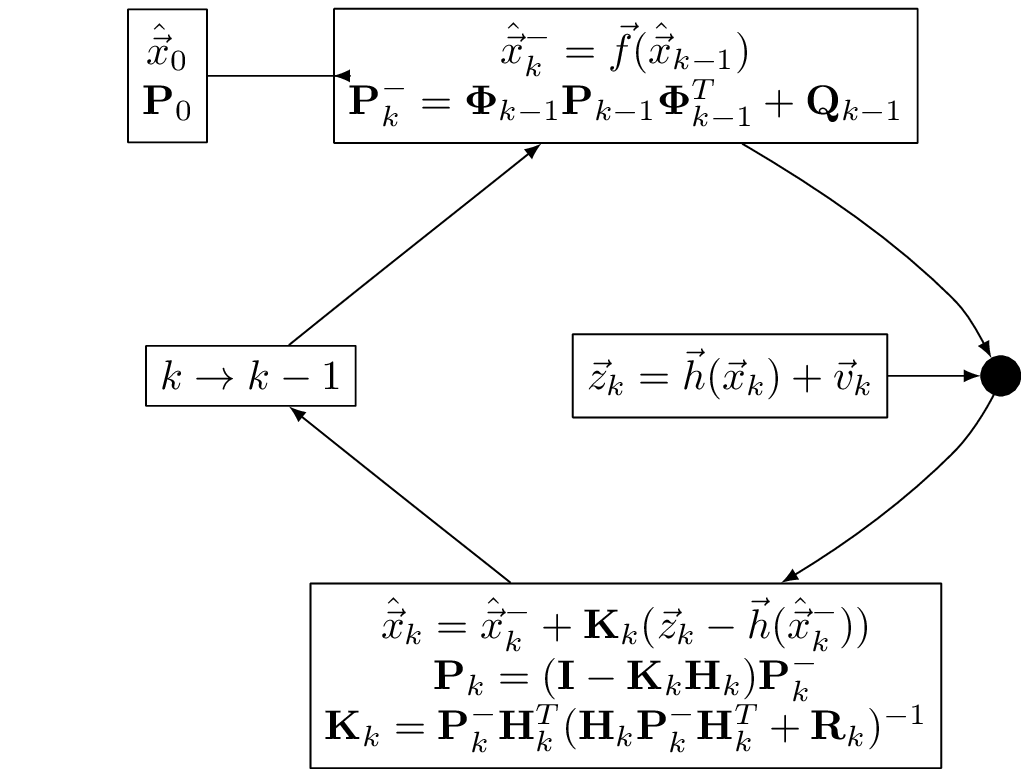
Pinson-9 model for inertial navigation
(Titterton and Weston 2004), (Raquet 2021)
Pinson 9-state model for INS is: \[ \vec{x} = \begin{bmatrix} \delta x_n \\ \delta x_e \\ \delta x_d \\ \delta v_n \\ \delta v_e \\ \delta v_d \\ \delta\epsilon_n \\ \delta\epsilon_e \\ \delta\epsilon_d \\ \end{bmatrix} = \begin{bmatrix} \delta\vec{x} \\ \delta\vec{v} \\ \delta\vec{\epsilon} \\ \end{bmatrix} \]
Where:
- \(\delta\vec{x}\) are the NED position error states
- \(\delta\vec{v}\) are the NED velocity error states
- \(\delta\vec{\epsilon}\) are the angle atittude errors
and \[ \dvec{x} = \mat{F} \vec{x} \]
Pinson-9 model propagation
\[ \begin{bmatrix} \delta\dvec{x} \\ \delta\dvec{v} \\ \delta\dvec{\epsilon} \end{bmatrix} = \begin{bmatrix} F_{xx} & F_{xv} & F_{x\epsilon} \\ F_{vx} & F_{vv} & F_{v\epsilon} \\ F_{\epsilon x} & F_{\epsilon v} & F_{\epsilon \epsilon} \\ \end{bmatrix} \begin{bmatrix} \delta \vec{x} \\ \delta \vec{v} \\ \delta \vec{\epsilon} \\ \end{bmatrix} \] We are working in geodetic coordinates so the elements of \(\mat{F}\) depend upon Earth specifc parameters to account for Coriolis force.
Pinson-9 model propagation definitions
| Variable | Description | Value/Units |
|---|---|---|
| \(\phi\) | latitude | radian |
| \(v_n\) | north velocity | meter/second |
| \(v_e\) | east velocity | meter/second |
| \(v_d\) | down velocity | meter/second |
| \(f_n\) | north specific force | meter/second/second |
| \(f_e\) | east specific force | meter/second/second |
| \(f_d\) | down specific force | meter/second/second |
| \(R_\earth\) | Earth radius | 635300 meter |
| \(\Omega_\earth\) | Earth rotation rate | 7.2921151467e-5/second |
Components of \(\mat{F}\), \(F_x\) row
\[ F_{xx} = \begin{bmatrix} 0 & 0 & -\frac{v_n}{R_\earth^2}\\ \frac{v_e \tan \phi}{R_\earth\cos \phi} & 0 & \frac{v_e}{R_\earth^2 \cos\phi} \\ 0 & 0 & 0 \\ \end{bmatrix} \]
\[ F_{xv} = \begin{bmatrix} \frac{1}{R_\earth} & 0 & 0\\ 0 & \frac{1}{R_\earth\cos\phi} & 0 \\ 0 & 0 & -1 \\ \end{bmatrix} \]
\[ F_{x\epsilon} = \mat{0}_{3\times 3} \]
\(F_v\) row of \(\mat{F}\)
\[ F_{vx} = \begin{bmatrix} v_e \left( 2\Omega_\earth\cos\phi + \frac{v_e}{R_\earth\cos^2\phi} \right) & 0 & \frac{v_e^2\tan\phi - v_n v_d}{R_\earth^2}\\ 2\Omega_\earth \left(v_n \cos\phi - v_d \sin\phi\right) + \frac{v_n v_e}{R_\earth \cos^2\phi} & 0 & \frac{-v_e (v_n\tan\phi +v_d)}{R_\earth^2}\\ 2\Omega_\earth v_e \sin \phi & 0 & \frac{v_n^2 + v_e^2}{R_\earth} \\ \end{bmatrix} \]
\[ F_{vv} = \begin{bmatrix} \frac{v_d}{R_\earth} & -2 \left( \Omega_\earth \sin\phi + \frac{v_e\tan\phi}{R_\earth} \right) & \frac{v_n}{R_\earth} \\ 2\Omega_\earth\sin\phi + \frac{v_e\tan\phi}{R_\earth} & \frac{v_n\tan\phi+v_d}{R_\earth} & 2\Omega_\earth \cos\phi + \frac{v_e}{R_\earth} \\ -\frac{2v_n}{R_\earth} & -2 \left( \Omega_\earth \cos\phi + \frac{v_e}{R_\earth} \right) & 0 \\ \end{bmatrix} \]
\[ F_{v\epsilon} = \begin{bmatrix} 0 & -f_d & f_e \\ f_d & 0 & -f_n \\ -f_e & f_n & 0 \end{bmatrix} \]
\(F_\epsilon\) row of \(\mat{F}\)
\[ F_{\epsilon x} = \begin{bmatrix} -\Omega_\earth \sin\phi & 0 & -\frac{v_e}{R_\earth} \\ 0 & 0 & \frac{v_n}{R_\earth^2} \\ -\Omega_\earth \cos\phi - \frac{v_e}{R_\earth \cos^2\phi} & 0 & \frac{v_e\tan\phi}{R_\earth^2} \end{bmatrix} \]
\[ F_{\epsilon v } = \begin{bmatrix} 0 & 1/R_\earth & 0 \\ -1/R_\earth & 0 & 0 \\ 0 & \frac{\tan\phi}{R_\earth} & 0 \\ \end{bmatrix} \]
\[ F_{\epsilon\epsilon} = \begin{bmatrix} 0 & -\Omega_\earth\sin\phi + \frac{v_e}{R_\earth\tan\phi} & v_n/R_\earth \\ \Omega_\earth\sin\phi + \frac{v_e\tan\phi}{R_\earth} & 0 & \Omega_\earth\cos\phi + v_e/R_\earth \\ -v_n/R_\earth & -\Omega\cos\phi -v_e/R_\earth & 0 \\ \end{bmatrix} \]
Pinson-15 state model
- Extends the 9-state model to include
- accelerometer \(\vec{b_a}\) and gyro \(\vec{b_g}\) biases
- using First Order Gauss Markov model (FOGM)
\[ \vec{x} = \begin{bmatrix} \delta x_n \\ \delta x_e \\ \delta x_d \\ \delta v_n \\ \delta v_e \\ \delta v_d \\ \delta\epsilon_n \\ \delta\epsilon_e \\ \delta\epsilon_d \\ b_{a_x} \\ b_{a_y} \\ b_{a_z} \\ b_{g_x} \\ b_{g_y} \\ b_{g_z} \\ \end{bmatrix} = \begin{bmatrix} \delta\vec{x} \\ \delta\vec{v} \\ \delta\vec{\epsilon} \\ \vec{b_a}\\ \vec{b_g}\\ \end{bmatrix} \]
Propagation for 15-state Pinson model
\[ \begin{bmatrix} \delta\dvec{x} \\ \delta\dvec{v} \\ \delta\dvec{\epsilon} \\ \dvec{b_a}\\ \dvec{b_g}\\ \end{bmatrix} = \begin{bmatrix} F_{xx} & F_{xv} & 0 & 0 & 0\\ F_{vx} & F_{vv} & F_{v\epsilon} & \mat{C}_b^n & 0 \\ F_{\epsilon x} & F_{\epsilon v} & F_{\epsilon \epsilon} & 0 & -\mat{C}_b^n \\ 0 & 0 & 0 & F_{aa} & 0 \\ 0 & 0 & 0 & 0 & F_{gg} \\ \end{bmatrix} \begin{bmatrix} \delta \vec{x} \\ \delta \vec{v} \\ \delta \vec{\epsilon} \\ \vec{b}_a\\ \vec{b}_g\\ \end{bmatrix} \]
\[ F_{aa} = \begin{bmatrix} -1/\tau_a & 0 & 0 \\ 0 & -1/\tau_a & 0 \\ 0 & 0 & -1/\tau_a\\ \end{bmatrix},\ F_{gg} = \begin{bmatrix} -1/\tau_g & 0 & 0 \\ 0 & -1/\tau_g & 0 \\ 0 & 0 & -1/\tau_g\\ \end{bmatrix} \] and \(\mat{C}_b^n\) is the direction cosine matrix that rotates from body to NED frame.
MagNav additions to Pinson-15
- Add a barometer altimeter to constrain Altitude
- \(\delta h_a\) is the altitude error correction to the INS
- \(\delta a\) is the vertical acceleration error (we already have \(\delta v_n\) in Pinson-9)
- Add a state \(S\) to model external time-correlated magnetic field variations
- space weather
- effects must be out-side of navigation frequency band
Results in an 18-component state vector \[ \begin{bmatrix} \delta \vec{x} & \delta \vec{v} & \delta \vec{\epsilon} & \vec{b}_a & \vec{b}_g & \delta h_a & \delta a & S \end{bmatrix} \]
Updates to \(\mat{F}\) matrix
\[ \begin{bmatrix} \delta\dvec{x} \\ \delta\dvec{v} \\ \delta\dvec{\epsilon} \\ \dvec{b}_a\\ \dvec{b}_g\\ \dot{h_a}\\ \dot{\delta_a}\\ \dot{S} \end{bmatrix} = \begin{bmatrix} F_{xx} & F_{xv} & 0 & 0 & 0 & F_{xb} & 0 \\ F_{vx} & F_{vv} & F_{v\epsilon} & \mat{C}_b^n & 0 & F_{vb} & 0 \\ F_{\epsilon x} & F_{\epsilon v} & F_{\epsilon \epsilon} & 0 & -\mat{C}_b^n & 0 & 0 \\ 0 & 0 & 0 & F_{aa} & 0 & 0 & 0\\ 0 & 0 & 0 & 0 & F_{gg} &0 & 0 \\ F_{bp} & 0 & 0 & 0 & 0 & F_{bb} & 0 \\ 0 & 0 & 0 & 0 & 0 & 0 & F_{ss} \\ \end{bmatrix} \begin{bmatrix} \delta \vec{x} \\ \delta \vec{v} \\ \delta \vec{\epsilon} \\ \vec{b}_a\\ \vec{b}_g\\ \delta h_a \\ \delta a \\ S \end{bmatrix} \]
Updated \(\mat{F}\) components
Barometer aiding: \[ \mat{F}_{xb} = \begin{bmatrix} 0 & 0 \\ 0 & 0 \\ k_1 & 0 \end{bmatrix},\ \mat{F}_{vb} = \begin{bmatrix} 0 & 0 \\ 0 & 0 \\ -k_2 & 1 \\ \end{bmatrix} \]
\[ \mat{F}_{bx} = \begin{bmatrix} 0 & 0 & 0\\ 0 & 0 & k_3 \\ \end{bmatrix},\ \mat{F}_{bb} = \begin{bmatrix} -\frac{1}{\tau_b} & 0 \\ -k_3 & 0 \\ \end{bmatrix} \]
The space weather, diurnal bias is given by: \[ \mat{F}_{ss} = \frac{1}{\tau_s} \]
MagNav measurement processor
The scalar sensor measures: \[ |\vec{B}_\text{total}| = |\vec{B}_\ext + \vec{B}_\text{\faPlane} | \] and \[ \vec{B}_\ext = \vec{B}_\earth+ \vec{B}_\text{anomaly} + \vec{B}_\text{disturbance} \]
- We added a state \(S\) into the MagNav model to account for \(\vec{B}_\text{disturbance}\).
- \(\vec{B}_\earth\) from IGRF or WMM
- Both IGRF and WMM are functions of lat, long, altitude and time
- WMM has \(28.8^\circ\) or 3200 km at surface resolution
- Secular variaton \(\approx 100 \text{nT}/\text{year} = 0.27 \text{nT}/\text{day}\)
MagNav Measurement Processor \(H\) matrix
\[ \begin{aligned} \vec{z} & \approx \vec{h}(\vec{x}^*, t) + \mat{H} \cdot \Delta\vec{x} + \vec{v}(t) \end{aligned} \]
\[ \mat{H} = \left[ \frac{\partial \vec{h}}{\partial \vec{x}}\right]_{\vec{x}=\vec{x}^*} \]
\[ \mat{H}(\vec{x}^*) = \begin{bmatrix} \frac{\partial h(\vec{x}^*)}{\partial x_n} \\ \frac{\partial h(\vec{x}^*)}{\partial x_e} \\ \frac{\partial h(\vec{x}^*)}{\partial x_d} \\ \mat{0}_{1x15} \end{bmatrix} \leftarrow\text{This is the gradient of the map} \] Both the map and 3D gradient of the map are needed in order to make a measurement and incorporate it.
Navigation pre-processor
- Prepare Magnetic Anomaly Map
- Upward continue as needed for flight altitudes
- Compute 3-D gradient for measurement processor
- Precompute Core field model as needed
- Prepare Tolles-Lawson Compensation coefficients
- In an adaptive or online calibration this is a starting point
Filter initialization
- Assume known starting value for position and attitude from GPS-aided system
- Tolles-Lawson coefficients are needed
- Works well for EKF - provides excellent starting point for state
- State starting point initializes map error state \(S\)
- Particle filter initialization
- Randomly draw ensemble of \(N\) particles from my anticpated distribution
- This includes a position \(\vec{x}\) and map bias \(S\) hypothesis
MagNav.jl
Navigation code
MagNav.jl software does not have it’s own INS mechanization code
- relies on an INS to provide the solution around which the EKF is linearized
- fine provided that the solution remains in the linear regime
- too much INS drift will break this assumption
- Two-dimensional navigation
- aircraft is assumed at constant altitude
Data for Navigation
- traj: GPS truth trajectory
- ins: pure inertial trajectory solution
- map: magnetic anomaly maps at flight altitude
- mag: magnetic measurement data from aircraft
- Use Tolles-Lawson calibration computed earlier
- ground station for diurnal and space weather
Find flight path for navigation
Code
2 rows × 8 columns
| flight | line | t_start | t_end | full_line | map_name | map_type | traj_alt | |
|---|---|---|---|---|---|---|---|---|
| Symbol | Float64 | Float64 | Float64 | Bool | Symbol | Symbol | Int64 | |
| 1 | Flt1006 | 1006.08 | 55770.0 | 56609.0 | 1 | Eastern_395 | HAE | 397 |
| 2 | Flt1006 | 1006.09 | 56965.0 | 57480.0 | 0 | Eastern_395 | HAE | 574 |
Plot navigation trajectory (GPS)
Entire map
Plot navigation trajectory (GPS and INS)
Entire map
Zoom on selected flight line
Code
GPS track
INS only
Notice overall shift between tracks
Set up data for navigation
Uncorrected GPS and INS tracks
Code
\(\rightarrow\)
Shifted GPS and INS tracks
Upward continue and prepare map
Compare map value with magnetometer values
Create EKF filter model
FOGM filter tuning parameters
EKF filter generation
Run the filter
Mag 4 DRMS Error = 149.2 meter
Mag 5 DRMS Error = 82.5 meter
INS DRMS Error = 137.5 meter
North position error
Code
tt_min = (traj.tt .- traj.tt[1])./60;
p=error_plot(tt_min,filt_out_4.n_err,filt_out_4.n_std, color=:blue, label="Mag 4, North error",xlabel="Time [minutes]", ylabel="North Error [meters]")
error_plot(p,tt_min,filt_out_5.n_err,filt_out_5.n_std, color=:green,label="Mag 5, North error",xlabel="Time [minutes]", ylabel="North Error [meters]")
plot(p; double_pane_defs...)East position error
Code
p=error_plot(tt_min,filt_out_4.e_err,filt_out_4.e_std, color=:blue, label="Mag 4, East error",xlabel="Time [minutes]", ylabel="East Error [meters]")
error_plot(p,tt_min,filt_out_5.e_err,filt_out_5.e_std, color=:green, label="Mag 5, East error",xlabel="Time [minutes]", ylabel="East Error [meters]")
plot(p; double_pane_defs...)Inertial only solution
Plot filter results
Conclusion
Conclusion
You should be familiar with Magnetic Navigation
- Maps
- Calibration
- Navigation
You should know how to use MagNav.jl to explore navigation
- software
- data
Questions?
ANT Center
Contact information
Contact information
Aaron Nielsen
Air Force Institute of Technology (AFIT) https://www.afit.edu
Autonomy and Navigation Technology Center (ANT Center) https://www.afit.edu/ANT/
References
Backups
Maps
Scalar magnetic potentials
Scalar Magnetic Potential \(\Phi_M\)
- If \(\vec{J} = 0\), then \(\nabla \times \vec{H} = 0\)
- \(\vec{H}(\vec{r}) = -\nabla \Phi_M(\vec{r})\)
- and since \(\nabla \cdot \vec{B} = 0 \rightarrow \nabla^2 \Phi_M(\vec{r}) = 0\)
- LaPlacian equation: \(\nabla^2 \Phi_M(\vec{r}) = 0\)
- Solutions are often referred to as harmonic (sins and cosins)
- This situation holds for many airborne problems
Scalar Potential Theory
A procedure to transform magnetic scalar potential \(\Phi_M\) in free space.
From Laplacian we can write (Green’s third identity) \[
\Phi_M(\vec{r}) = \frac{1}{4\pi} \int_S \left( \frac{1}{r} \frac{\partial \Phi_M}{\partial n} -
\Phi_M \frac{\partial}{\partial n} \frac{1}{r} \right) dS
\]

- No sources in region \(R\)
- Know \(\Phi_M\) on the surface \(S\) that bounds \(R\)
- We can find \(\Phi_M\) anywhere in \(R\)
- (Blakely 1995)
Hemispherical geometry - flat Earth model
- Think of Earth’s surface as an infinite flat plane, all sources below
- Measure the potential on a plane above the earth
- Other side of hemisphere is \(\infty\) away and therefore zero potential
- Potential anywhere inside can be computed
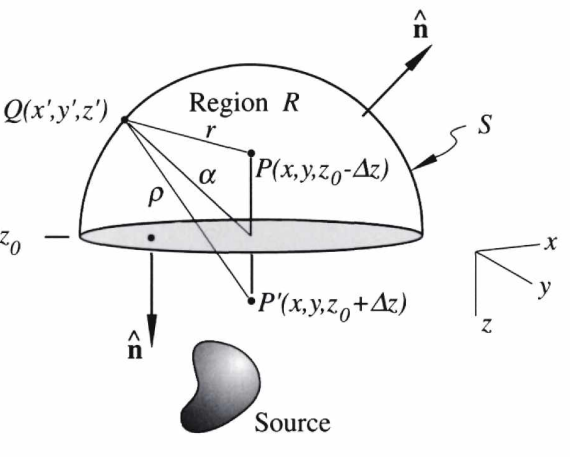
Fourier methods for potential theory
- Goal: find the potential \(\Phi_M\) on a plane parallel to a known plane
- Process: double integral over the surface of the known plane
- Ends up looking like a 2-D Fourier transform over spatial coordinates
- (Blakely 1995)


ION/IEEE PLANS MagNav Tutorial 2023
